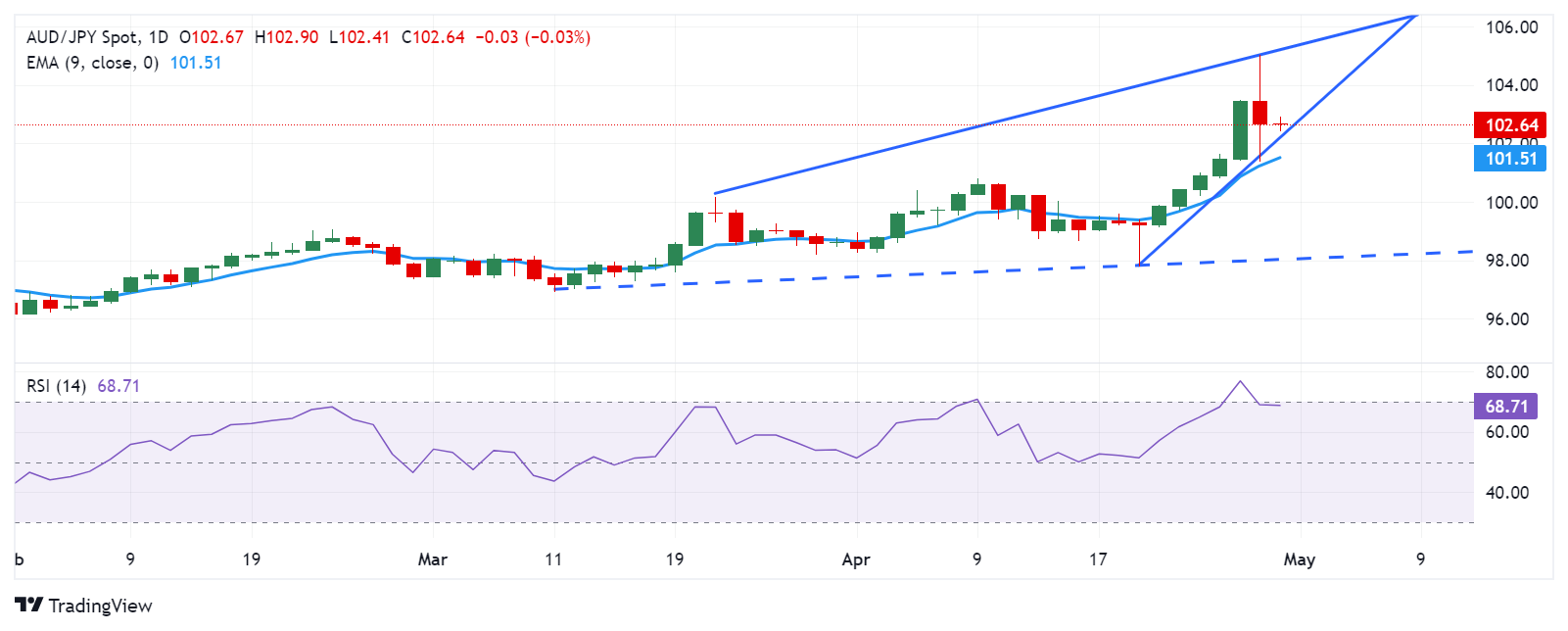AUD/JPY loses ground on weaker Aussie Retail Sales amid mixed Chinese data
- Markets in 2026: Will gold, Bitcoin, and the U.S. dollar make history again? — These are how leading institutions think
- US Q4 Earnings Season Set to Begin: Can US December CPI Data Bolster Rate Cut Case? [Weekly Preview]
- Gold Price Forectast: XAU/USD rises above $4,600 on US rate cut expectations, Fed uncertainty
- US Dollar Index steadies above 99.00 ahead of Retail Sales, PPI data
- WTI maintains position above $59.00 as supply risks grow
- Silver Price Forecast: XAG/USD corrects to near $86.50 as Iran stops killing protesters

■ The Australian Dollar loses ground after the release of lower-than-expected Retail Sales.
■ The Australian Retail Sales for March took an unexpected downturn, contrasting with the anticipated rise.
■ Market participants will closely monitor for any potential Japanese intervention on Tuesday.
AUD/JPY edges lower on Monday after the release of the lower-than-expected Aussie Retail Sales, a leading indicator that has a direct correlation with inflation and growth prospects, could impact the RBA’s hawkish stance on interest rate trajectory. However, the Australian Dollar (AUD) strengthened as higher-than-expected domestic inflation data raised expectations that the Reserve Bank of Australia (RBA) may not cut interest rates soon.
Australia's largest mortgage lender, Commonwealth Bank has adjusted its forecast for the timing of the first interest rate cut by the RBA. They are now projecting only one cut in November, as reported by the Financial Review. CBA anticipates that the Reserve Bank of Australia' could decrease the cash rate to 4.1% from 4.35% this year, with a more substantial drop to 3.1% by 2025. Gareth Aird, CBA's head of Australian economics, stated, "We have penciled in one 25 basis point rate cut in each quarter over 2025."
On the Japanese side, market participants will remain vigilant for potential Japanese intervention on Tuesday, following reports of Tokyo's involvement in the currency market on Monday, which propelled the Japanese Yen (JPY), according to Reuters. Lower-than-expected domestic Retail Trade data released on Tuesday support the dovish stance of the Bank of Japan (BOJ). Additionally, expectations for a sustained significant interest rate differential between Japan and other nations suggest that the trajectory of the JPY is biased toward further depreciation.
Daily Digest Market Movers: AUD/JPY edges lower after softer Retail Sales
The seasonally adjusted Australian Retail Sales dropped 0.4% MoM in March, compared to the expected increase of 0.2% and the previous growth of 0.3%.
China’s NBS Manufacturing Purchasing Managers Index (PMI) fell to 50.4 in April, against the 50.8 prior. The reading was better than the expected reading of 50.3. Non-manufacturing PMI declined to 51.2, as expected. The previous reading was 53.0 in March.
Japan’s Retail Trade increased by 1.2% year-over-year in March, which was lower than the expected increase of 2.5% and the previous increase of 4.7%. The seasonally adjusted Retail Trade (MoM) decreased by 1.2%, against the expected rise of 0.6%.
Australian shares kicked off Tuesday with little change, as investors paused ahead of the upcoming US Federal Reserve rates decision on Wednesday. Among the 11 sectors, only materials showed gains, while the rest remained relatively unchanged.
Masato Kanda, Japan's senior currency diplomat, made pointed comments regarding the currency's impact on import prices, emphasizing its significant influence. He highlighted the readiness of authorities to take action around the clock to address currency-related matters, as per a Reuters report.
BoJ Governor Kazuo Ueda provided insights into the central bank's decision to maintain the status quo during the post-policy meeting press conference on Friday. Ueda outlined that the BoJ will adjust the degree of monetary easing if the underlying inflation rate rises. Additionally, He emphasized that easy financial conditions will be maintained for the time being, indicating the BoJ's commitment to supporting economic recovery and stability through accommodative monetary measures.
Technical Analysis: AUD/JPY maintains position above 102.00
The AUD/JPY traded around 102.70 on Tuesday, hovering above the lower boundary of the ascending triangle on a daily chart. Additionally, the 14-day Relative Strength Index (RSI) is above the 50-level, reinforcing the bullish sentiment.
The immediate resistance is observed at the psychological level of 105.00, coinciding with the upper boundary of the triangle. A breakthrough above this area could propel the AUD/JPY cross to test the highest level of 105.43 recorded in April 2013.
On the downside, immediate support for the AUD/JPY pair might be encountered at the psychological level of 102.00, aligning with the lower boundary of the triangle. If the pair breaches below this level, it could lead to a further decline toward the nine-day Exponential Moving Average (EMA) at 101.51.
AUD/JPY: Daily Chart
Read more
* The content presented above, whether from a third party or not, is considered as general advice only. This article should not be construed as containing investment advice, investment recommendations, an offer of or solicitation for any transactions in financial instruments.





